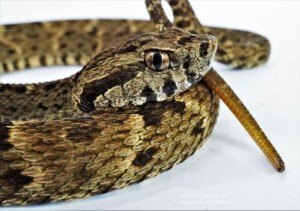The Lance Head Pit Viper (Bothrops atrox) and anecdotes of Amazonian snake pseudo-biology
This cryptic snake has the title of claiming the most bite victims in Central and South America. They have such a terrific camouflage that it is easy to step on one if you are not paying attention. For that reason and the fact that they adapt to live around humans make them the #1 reptile to watch out for while living in the neo-tropics.
The Lancehead is known for many names, Jergon -PE, Barba Amarilla -CR. Jararaca- BR. For ease of reading though this will be about the Bothrops atrox of Loreto-Peru.
The juvenile of this species is often incorrectly identified as “cascabels” or rattle snake by locals, not recognizing that it will grow into what they know as “Jergon” (the adult Bothrops atrox). Even some very highly acclaimed “survival” guides from this region still insist that there are rattle snakes here in lowland Amazonia, and when confronted with a Juvenile lancehead, the first thing they say is “rattlesnake”.
Why do people insist there are rattlesnakes in Loreto-Peru? For one, it’s a lack of formal biological knowledge but it also stems from a deep seeded teaching from their ancestors. Anything unknown is dangerous and should be avoided and feared. Some of the stories told by elders get passed on like religion to the children.
When threatened, many species of snake will vibrate their tail against the leaf litter of forest floor as a warning. They are warning of their presence for the benefit of both snake and human. If the warning works, then the human will take notice and steer clear of the danger zone. The tip of the tail of the juvenile Bothrops atrox is colored bright yellow. Not only does this make the snake more visible when vibrating but when performed correctly, the snake will use the tail as a lure to draw in prey items.
Not a grub!
The sulfur tail can be wagged menacingly in the air or against the ground, mimicking a grub or larvae freshly fallen on the forest floor. This is called Caudal Luring. If played out correctly, the lure will attract any small organism to the snake for food. The prey item thinks its going to get a meal when in reality it will get two hypodermic needles in the body for a quick and painful death.
The tail vibration makes people believe in the presence of rattle snakes in Loreto, aside from all other evidence, people will continue to believe the tall tales as well as other folklore. No biology degree can convince a local easily what they have been taught as a child is wrong (unless the degree is their own)
Deadly viper
A really neat note about the biology of the Jergon is that this species is ovoviviparous meaning, the young are formed inside the mother, encapsulated in their own sac containing yolk. They are not connected to the mother’s circulatory system as in viviparity (mammals). The eggs are retained by the mother inside her body! When the young are ready, they hatch inside and slide out alive giving the appearance of live birth!
There are several other snake species in the Amazon that have similar reproductive strategies such as the famous anaconda. This has certain evolutionary advantages, not having to care for a nest, not having to form a tough egg. One of the main disadvantages though, is the fewer number of offspring and the weight of the babies inside the mother can be a real drag…Pun intended.
Percentage wise, the juveniles’ venom is more potent than the adult venom. They need to drop their prey item quickly so they won’t waste energy tracking the food down after the bite. Unlike adults, the young snakes commonly dump all the contents of their venom glands in a single bite, that is one of the reasons why they are the deadliest snakes of the Americas.
The adult lancehead can reach over 6 ft long, and enjoys hanging out on the edges of ecosystems or ecotones, where two habitats meet. (Proven higher diversity and quantity of prey items). Contrary to popular belief, they do not want to bite you. They are just as sacred of you and would warn ahead of time so they don’t get stepped on. On several occasions, while hiking in the forest at night. I have witnessed the lancehead alert its presence by flashing the underside of his chin. In the dark, the bright chin patch stands out and serves as a little warning flag to potential accidental stomping. Quite possibly, they may use this technique when a tapir or another terrestrial organism approaches that is not on the menu to avoid conflicts.
For the most part, the snake will do everything possible to avoid biting a human. On one occasion I was not paying enough attention and I was surprised to see the head of an adult female jergon lashing out in front of me, TWICE. Strange thing is though, my leg was only inches from her, and she (THANK GOODNESS) was purposely missing. Aside from purposely missing, there are many cases of what doctors would call a “dry bite” when the snake punctures the flesh but does not inject any venom.
The facts is: These snakes are not aggressive, and avoid conflicts if possible. The majority of bites come from them actually being stepped on or someone mishandling them.
Dispelling lies about snakes is a favorite pastime.
Given the opportunity, I like to talk to locals about correctly identifying snakes and how they aren’t all dangerous. Most people do not believe when I tell them there are more non-venomous species than there are venomous. For many locals, the only good snake is a dead snake. There are some exceptions to the rule, such as my neighbor Blanca, who stores rice and maize. She is familiar with red-tail and rainbow boas and will order them to be released in her grain stores to keep the rat/mouse population at bay. YEA BLANCA! Ms. Blanca has been doing this long before we met me so I can’t take any credit for her excellent use of biodiversity.
Passed down knowledge is hard to counteract. The stories have been relayed who knows how many generations and translations ago. There are people who believe that the Jergon can be vanquished by stealing its venom stash that was temporarily deposited on a leaf by the snake when it drinks water. Many woodsmen swear to me, they have witnessed that when a jergon is thirsty, it will empty its venom glands on a leaf next to the creek and proceed to drink water.
While the snake is distracted, the woodsmen would dash in quickly to steal the venom holding leaf. The venom is tossed aside by the woodsman and the snake will whither and die. Sounds like a horribly complicated design for the snake, that if were true, would have led the jergon to extinction a long time ago. What happens when it rains? The snake won’t drink any water?
This one was found very close to out walkway
There is another fanciful serpentine tale that deals with reproductive biology. The local belief is that many species of snakes are born from the clutch of one species. When dispelling biology lies to locals this particular case always come up. Woodsmen swear they have found a coral snake nest, and when the babies hatch out, they are from several species of snake. Also, all the babies that hatch out of the single nest are all the venomous ones such as Bothrops, Bothropsis, Lachesis , and Micrurus (viper and coral snake species). Needless to say, that is false. I commonly rebut such a story asking if they ever saw a human giving birth to a monkey, or a chicken birthing a duck, but generally the superstitious belief wins after I disappear. While I know the comparison isn’t exact but it gives the general idea that the concept is ridiculous.
In the meantime, I will be fighting the good fight. Teaching how beneficial biodiversity can be for us and not only in medicinal form but through actual interaction like Ms. Blanca knows. If you put a snake in your grain storage, there will be less rodents.
The snakes should not be feared, but respected. They fill important ecological niches all over the world.
Just to quell some fears some may have about travelling to areas where the Lancehead is common so here are few tips
Prevention:
After learning all of this, its easier to avoid a bite.
#1 Always follow your guide, do not stray off of trails.
#2 Always wear the tall rubber boots, they will prevent %100 of bites from juveniles on the ground.
#3 Stay alert and for goodness sake touch nothing!
#4 Edges of conjoining ecosystems (ecotones) are top niches for these snakes so extra alert near edges.
#5 Terrestrial organisms are concentrated during flood season so extra caution in our area Feb-June.
#6 During the day, these snakes are not very active. They are coiled comfortably or basking in a rare patch of sunlight , rarely moving around during the day. Their movements are mainly crepuscular when they search for a new location to coil up and wait for passing prey.
Although after 15 years we have never had an incident from a snake bite, it is always a good idea to be prepared when working in ecotourism. In the occasion of a bite, there is a small hospital in the village of Oran where two types of antivenom can be administered by doctors. After the first dosage, immediate evacuation to Iquitos is needed. Once again ZERO INCIDENTS IN 15 YEARS OF RAINFOREST ADVENTURE TRAVEL!






